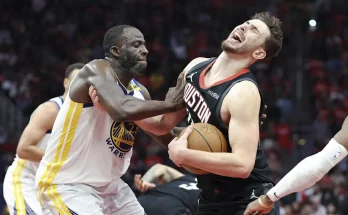The college football recruiting trail has always been full of twists, surprises, and last-minute decisions that can swing the momentum of a program. Few examples show this better than the case of four-star offensive tackle Kamari Blair, who made waves in the recruiting world when he flipped his commitment from the South Carolina Gamecocks to the Tennessee Volunteers. For both programs, this was a development that reflected not only the competitive nature of recruiting in the SEC but also the shifting balance of power in a conference where every roster addition can make a monumental difference. Blair’s flip underscores Tennessee’s continued upward trajectory under head coach Josh Heupel while simultaneously raising questions about South Carolina’s ability to hold onto elite talent in a fiercely contested region.
Blair’s recruitment had been closely monitored for months. As a four-star offensive tackle, he stood out not just for his physical tools but also for his potential to anchor an offensive line at the highest level of college football. Offensive tackles of his caliber are always in demand, and schools across the SEC and beyond had been actively pursuing him. For much of the recruiting cycle, it looked as if South Carolina had landed a gem, a statement recruit who could fortify the trenches and elevate the Gamecocks’ offense. Shane Beamer and his staff celebrated when Blair originally pledged his commitment, viewing it as evidence of their ability to compete with traditional SEC powers in the recruiting space. But as is so often the case in college football, the story did not end there.
Tennessee, always a major player in SEC recruiting battles, had never backed away from pursuing Blair even after his commitment to South Carolina. The Volunteers’ coaching staff recognized both his talent and his potential cultural fit within their system. With Tennessee’s offensive scheme predicated on pace, physicality, and protecting the quarterback, adding an offensive tackle like Blair was a priority. Their persistence ultimately paid off, as Blair announced his decision to flip to the Vols, stunning many in the recruiting world. For Tennessee, this was more than just a recruiting win; it was another affirmation that their program has regained credibility and momentum in the eyes of top prospects.
One of the primary reasons Blair’s decision resonates so strongly is the current landscape of the SEC. With programs like Georgia, Alabama, and LSU consistently stacking elite recruiting classes, teams like Tennessee and South Carolina must fight even harder to carve out their place in the hierarchy. Tennessee’s ability to secure Blair is not just about one player; it’s about continuing to stockpile the kind of talent that will allow them to consistently compete with the elite of the conference. For South Carolina, losing Blair represents a setback in their efforts to build the kind of offensive line depth necessary to withstand the rigors of an SEC schedule. In a league where games are often decided in the trenches, the loss of a high-profile offensive lineman is significant.
For Blair himself, the decision likely came down to a combination of fit, development, and trajectory. Tennessee has recently positioned itself as a program on the rise, with strong performances in recruiting and on the field. The Vols’ offense has become one of the most explosive in college football, and their ability to showcase linemen in a high-powered scheme can be attractive to recruits looking to prepare for the next level. Playing in front of one of the most passionate fan bases in the country at Neyland Stadium is also a draw. Blair’s flip can be seen as a recognition of Tennessee’s momentum and the belief that the Vols offer the best opportunity to maximize his potential.
For South Carolina, the challenge now is twofold. First, they must find a way to fill the void left by Blair’s departure, either by flipping another recruit, developing younger talent already on campus, or dipping into the transfer portal. Second, they must continue to convince recruits that the program is capable of holding its own against the SEC’s upper echelon. Beamer has made progress since taking over in Columbia, but moments like this highlight just how difficult the climb can be. Recruiting battles are often decided not only on facilities and coaching but also on perception. When a top recruit flips away, it can create a narrative that the program is struggling to keep pace, something South Carolina will have to counteract quickly.
The ripple effects of Blair’s flip extend beyond just these two programs. In the broader SEC landscape, every recruiting win or loss has implications for how rosters are built and how future seasons unfold. Tennessee’s addition of Blair strengthens their offensive line depth, which could have an impact not just in regular-season games but also in their ability to challenge for conference titles and beyond. South Carolina’s loss of Blair, meanwhile, places even greater importance on their ability to land other high-profile recruits and maintain the confidence of their current class. Recruiting is as much about momentum as it is about individual players, and how each program responds to this development will say a lot about their trajectory moving forward.
There’s also the personal element of Blair’s decision, which cannot be overlooked. For a young athlete, choosing a college program is one of the biggest decisions of his life, balancing football aspirations, academics, personal relationships, and long-term goals. Blair’s flip indicates that Tennessee offered him something South Carolina could not, whether that was a clearer path to early playing time, a stronger relationship with position coaches, or simply a belief in the program’s direction. These factors are often invisible to the outside world, but they play a crucial role in shaping recruiting outcomes. For Blair, the decision to join Tennessee reflects both confidence in himself and trust in what the Vols are building.
In terms of Tennessee’s offensive future, Blair’s addition should be seen as a critical step in ensuring stability up front. Offensive line play is often the difference between good and great teams in the SEC, and programs that consistently field dominant lines tend to be the ones competing for championships. Tennessee’s offense, with its emphasis on tempo and vertical passing, cannot function at its peak without reliable protection and run-blocking. Blair’s arrival signals that the Vols are serious about continuing to upgrade in the trenches, a necessary move if they want to sustain their recent success. His development under Tennessee’s staff could make him a cornerstone of their offensive line for years to come.
South Carolina, while disappointed by Blair’s flip, still has opportunities to bounce back. Recruiting is never static, and the same unpredictability that saw Blair flip to Tennessee could work in their favor with another player. They also have the ability to develop the talent already on their roster, something that every successful program must do in addition to recruiting well. Beamer’s challenge will be to ensure that the loss of Blair does not derail momentum for the rest of the class. Often, the ability to quickly pivot and respond to setbacks is what separates stable programs from those that spiral.
From a fan perspective, Blair’s decision will be viewed very differently depending on the side. Tennessee fans are likely celebrating another major recruiting victory, seeing it as a sign that their program is not only back but also capable of winning head-to-head battles for elite talent. For South Carolina fans, it’s undoubtedly a tough pill to swallow, a reminder of the constant uphill battle their program faces in recruiting. However, fans of both programs should recognize that recruiting is fluid, and one decision, while important, is part of a much larger picture. Players will continue to flip, classes will evolve, and the ultimate measure will come on the field.
Looking forward, Blair’s commitment to Tennessee could serve as a building block for further recruiting success. High-profile recruits often influence others, and his decision could encourage other offensive linemen or skill players to take a closer look at the Vols. Momentum in recruiting can be contagious, and the addition of a four-star offensive tackle is exactly the kind of move that can spark further excitement. Tennessee’s staff will undoubtedly look to capitalize on this moment, using Blair’s flip as proof of the program’s appeal and trajectory.
In the end, Kamari Blair’s flip from South Carolina to Tennessee is a microcosm of the larger world of SEC recruiting: highly competitive, unpredictable, and deeply impactful. For Tennessee, it’s a victory that bolsters their roster and reinforces their standing as a rising power in the conference. For South Carolina, it’s a setback that highlights the challenges of building and sustaining momentum in one of the toughest recruiting environments in the country. For Blair, it’s a decision that will shape his future, one that reflects both his individual goals and his belief in Tennessee’s direction. The story serves as a reminder that in college football, recruiting never sleeps, and the choices of a single player can ripple across programs and seasons.


